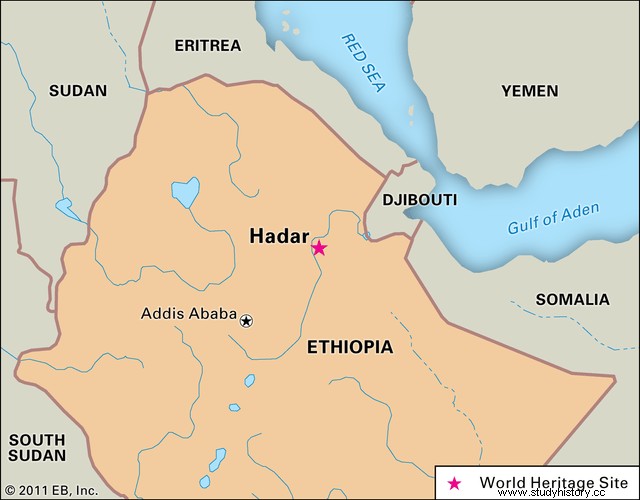Hadar , site of paleoanthropological excavations in the lower Awash River Valley in the Afar region of Ethiopia . It is in the northernmost part of the eastern (Great) Rift Valley Africa , about 300 km northeast of Addis Ababa . The lower valley of the Awash River, ie the Hadar area, has been declared a UNESCO World Heritage Site in 1980.

 Britannica Quiz Exploring Africa:Fact or Fiction? Though this continent is teeming with natural resources and diverse wildlife, how much do you really know about Africa? Sort these facts from Cairo to Khartoum in this African odyssey.
Britannica Quiz Exploring Africa:Fact or Fiction? Though this continent is teeming with natural resources and diverse wildlife, how much do you really know about Africa? Sort these facts from Cairo to Khartoum in this African odyssey. The Hadar Remnants include partial skeletons of Australopithecus afarensis , a key style in the human evolution . The main paleontological work began in Hadar in the early 1970s and was led by the American anthropologist Donald Johanson . His team discovered a 40 percent complete female skeleton from A. afarensis , which became popularly known as Lucy . The remains, dated to 3.2 million years ago, provided further evidence that in human evolution walking on two legs (bipedalism) preceded increased brain size. The pelvis and leg bones indicate an upright posture, but the cranial bones exhibit a limited cranial capacity similar to that of modern chimpanzees. The A. afarensis The bearing capacity at Hadar ranges from 3.4 to 2.9 million years and includes more than 200 fossils from a single one Site (Afar Locality 333) representing at least nine adults and four concurrently deposited juveniles. A thorough analysis of the remains reveals a pattern consistent with a single, highly variable species whose males were significantly larger than the females, although there is a possibility that the specimen instead consists of two different hominins (members of the human lineage). The site also has the earliest known remains of the human species Homo brought forth , which arose 2.3 million years ago, and some of the earliest known evidence of tool use.
Located at the intersection of the Arabian, Somali, and African tectonic plates, the Eastern Rift Valley has experienced significant geological upheaval. Over millions of years, numerous volcanic eruptions in Hadar deposited layers of volcanic ash and covered fossil remains with a series of layers that researchers have systematically identified and dated. Due to seismic activity combined with strong erosion, the Fossil record of the region gradually exposed , greatly reducing the amount of excavation required to locate hominin remains. These conditions make Hadar one of the world's richest sources of information on the physiology and habitats of hominin species.


